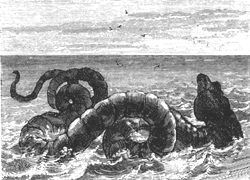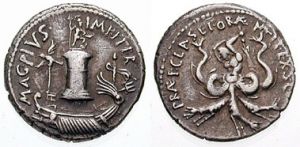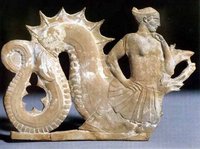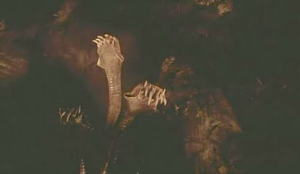In Greek mythology, Scylla, or Skylla (Greek Σκύλλα) is a horribly grotesque female sea monster.
Etymology
Several Greek words are associated with her name: hermit crab (Greek skyllaros), dog and dog-shark (skylax), and to rend (skyllô).
Description
Homer describes Skylla as a creature with twelve dangling feet, six long necks and grisly heads lined with with four eyes each a triple row of sharp teeth. The lower part of her body, consisted of six hideous dogs with mouth containing three rows of razor sharp teeth and a fish's tail. Her voice was likened to the yelping of dogs. With necks fully expanded, Scylla is 15 feet tall; the necks are 5 feet long each.
In classical art she was depicted as a fish-tailed sea-goddess, or mermaid, with a cluster of canine fore-parts surrounding her waist.
Some, again, describe her as a monster with six heads of different animals, or with only three heads (Tzetz. ad Lycoph. 650 ; Eustath. l. c.).
Family
She was one of the children of Phorcys and either Hecate, Crataeis, Lamia or Ceto (where Scylla would also be known as one of the Phorcydes). Some sources cite her parents as Triton and Lamia or Poseidon and Crataeis (Eustath. ad Hom. p. 1714), or of Typhon and Echidna (Hygin. Fab. praef.).
Places
Scylla and Charybdis are the names of two rocks between Italy and Sicily, and only a short distance from one another. In the midst of the one of these rocks which was nearest to Italy, dwelt, according to Homer, Scylla. Hidden in a cave at the bottom of a cliff, Scylla usually let her heads rearing up out of the chasm, gapping dolphins or any human or animal that would venture in the surroundings.
The opposite rock, which was much lower, contained an immense fig-tree, under which there dwelt Charybdis, who thrice every day swallowed down the waters of the sea, and thrice threw them up again. The two sides of the strait are within an arrow's range of each other, so close that sailors attempting to avoid Charybdis will pass too close to Scylla and vice versa.
The phrase between Scylla and Charybdis has come to mean being in a state where one is between two dangers and moving away from one will cause you to be in danger from the other. Scylla and Charybdis are believed to have been the entities from which the term, "Between a rock and a hard place" (ie: a difficult place) originated. Traditionally the aforementioned strait has been associated with the Strait of Messina between Italy and Sicily but more recently this theory has been challenged and the alternative location of Cape Skilla in north west Greece suggested.
Origins
According to Ovid Scylla was a nymph, daughter of Phorcys. The fisherman-turned-sea-god Glaucus fell madly in love with her, but she fled from him onto the land where he could not follow. Despair filled his heart. He went to the sorceress Circe to ask for a love potion to melt Scylla's heart. As he told his tale of love to Circe, she herself fell in love with him. She wooed him with her sweetest words and looks, but the sea-god would have none of her. Circe was furiously angry, but with Scylla and not with Glaucus. She prepared a vial of very powerful poison and poured it in the pool where Scylla bathed. As soon as the nymph entered the water she was transformed into a frightful monster with twelve feet and six heads, each with three rows of teeth. She stood there in utter misery, unable to move, loathing and destroying everything that came into her reach, a peril to all sailors who passed near her. Whenever a ship passed, each of her heads would seize one of the crew. Another tradition related that Scylla was beloved by Poseidon, and that Amphitrite, from jealousy, metamorphosed her into a monster (Tzetz. ad Lycoph. 45 ; Serv. ad Aen. iii. 420).
As retold by Thomas Bulfinch, Scylla was originally a beautiful nymph. She scorned her many suitors and chose to live among the Nereids instead, until one day Glaucus saw and fell in love with her. Glaucus was a mortal fisherman who had previously been transformed by chewing a plant, gaining the form of a fish from his waist down. When Glaucus declared his love to Scylla she fled, taking him for a monster. Glaucus sought the help of Circe, hoping that this witch could make Scylla to love him with her herbs, but Circe fell in love with Glaucus herself and asked him to forget Scylla. Glaucus rejected her request, declaring that his love for Scylla was eternal.
Stories
In Homer's Odyssey, Odysseus is given advice by Circe to sail closer to Scylla, for Charybdis could drown his whole ship when it sucked down the sea in her regular routine. Odysseus could sail by Skylla and take his losses or he could linger and fight Skylla, thus loosing the entire crew to Charybdis. It was a cruel choice for Odysseus but it got worse.
When Odysseus and his brave crew came to the Rovers, Odysseus put on his finest armor and stood with two spears scanning the rockface for any sign of Skylla. Regardless, he was still taken by surprise. They gave Charybdis a wide birth and sailed near Skylla's rock. While Charybdis kept their attention with her gushing and sputtering, Skylla swooped down unseen and snatched up six of the crew. Their legs and torsos were dangling from Skylla's mouths as she lifted them to her cave to eat them. They screamed for Odysseus and begged for help but he stood helpless on the deck with the rest of the terrified crew. Odysseus said it was the most pitiful scene his long-suffering eyes had ever seen. In a late Greek myth it was said that Heracles encountered Scylla when he brought back Geryon’s cattle, Scylla snapped up one cow and eats it. Herakles killed the monster but her father, the sea-god Phorcys, then applied flaming torches to her body and restored her to life.
It is said that by the time Aeneas' fleet came through the strait after the fall of Troy, Scylla had been changed into a dangerous rock outcropping which still stands there to this day.
Virgil (Aen. vi. 286) speaks of several Scyllae, and places them in the lower world (comp. Lucret. v. 893).
Theory about existence
It has been suggested that the myth of Scylla may have been inspired by real life encounters with giant squid (which are normally dying when near the surface), and she has some similar features to the kraken in Norse mythology and lusca in Caribbean mythology.
External links
- Theoi Project, Skylla references in classical literature and ancient art
- [1]Wikipedia,Scylla.




